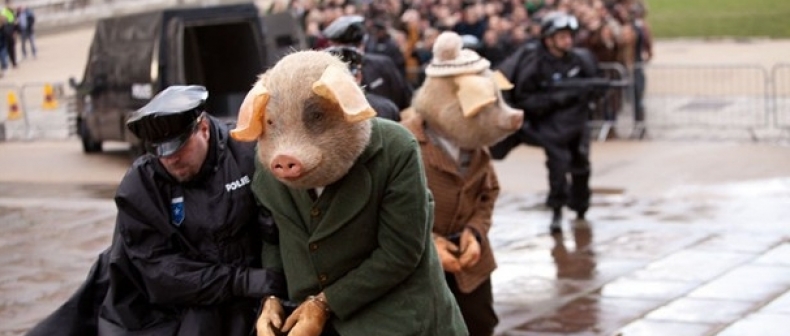
Written by an insider who has asked to remain nameless
It’s hard to believe, but the last time the Guardian produced a TV ad was 16 years ago, in 1986. The ad was the well-known and successful “Skinhead” spot, created by BMP, and can be seen here in all its mid-80s Camcorder glory.
Now, in 2012, in a totally different climate for newspapers, and at arguably the most important time for the organisation in its nearly 200-year history, the Guardian is about to launch a full rebrand. The campaign will lead with a slick new spot, this time from BBH and directed by Ringan Ledwidge, which airs for the first time tonight on Channel 4 at 22:10 GMT.
But, sexy and loyal readers of Toronto Standard, you can watch it here first. 

 Very rrrrousing. Are you rrrroused? I am. I’ve also had my mind scrambled slightly to see how far video production has come in less than two decades.
Very rrrrousing. Are you rrrroused? I am. I’ve also had my mind scrambled slightly to see how far video production has come in less than two decades.
Is it a success, though? Well, the ad has a few goals. This is the Guardian’s big chance to capitalise on what was probably the greatest year any paper has had since the Washington Post in 1972-73. The Guardian not only helped WikiLeaks break the US Embassy Cables, but brought down Rupert Murdoch‘s venerable News of the World, Britain’s biggest Sunday tabloid, for illegal phone hacking, and did such a locally relevant job of covering the Arab spring many Egyptians thought it was instrumental to Mubarak’s downfall.
It also wants to strike a big, bold, confident stance in a market that has altered radically since Skinhead. The tagline might still be The Whole Picture, but the new ad is obviously striving to reflect the Guardian’s new values. To summarise these in buzzwords (you know you want to), they are “mutualised” (2010), “open” (2011) and “digital-first” (2012). “Mutualised” basically means “collaborative with readers”, which is why you hear all those reader voices arguing fruitlessly with each other. “Open” means a lot of things: a commitment not to hide the Guardian behind an online paywall, sure — but also to liberate content from the exclusive preserve of ivory-tower journalists telling readers “the truth”, and shift instead towards a model where journalists “curate” material from a wide range of contributors: outside experts, local bloggers, readers themselves, etc. “Digital-first”, lastly, means the Guardian wants you to stop thinking of it as a print newspaper, and start thinking of it as, ahem, a multiplatform digital media service: websites, mobiles, digimobs, iPens, you know the drill. Print isn’t dead, it’s just in a low-rent care home. And you don’t visit nearly as often as you should.
Secretly, though, the Guardian has another problem. Namely, huge swaths of the UK think it’s staffed by the British Workers’ Guild of Sandal-Wearing Muesli-Knitters. Ask your average Daily Mail subscriber and they’ll tell you the Guardian is a rabble of leftwing bores who want us to all to hold hands in a big naked unshaven circle at the centre of a field of organic spelt. It’s not true, of course. Rather than sandals, most staff don’t wear shoes at all. (Just kidding.)
But American readers, crucially, don’t hold this prejudice. And the Guardian is trying hard to crack the US market, with a new team in the States and a US-specific version of its home page. (Hence, all the guns.) Luckily, the Guardian has a rep in the US for something like “edgy chutzpah”, which might seem a bit inflated but is highly preferable as a location on the positioning spectrum to “whiny PC cunt”.
That’s why you’ve got all the drums and the sly wit, the dawn raids and the riot squads, with none of the overt, politically correct moralising of Skinhead. The resulting ad is entertaining to watch. The complications of the Pigs’ case do indeed raise eyebrows. The resulting morass of exposed corruption and murky truth is exactly what good journalism uncovers. The music is impeccably rrrrrousing. And the effect of the overlapping voices and digital content platforms really does give an exciting impression of a paper where exciting things do, more than occasionally, happen.
You can feel the “but” coming, can’t you.
Here’s my concern: the whole thing feels, no doubt totally unintentionally, like a self-parody.
A still taken from the Guardian’s “Three Little Pigs” adBy making its central story a kids’ fairytale, the ad inadvertently makes the Guardian’s journalism seem absurdly self-important. All the opinion and outrage comes off as automatic — like those professional protesters who are paid to kick up a fuss.
This is particularly bad, because the news business has been accused of a factory system in which producing content, 24/7, regardless of quality, is far more important than ensuring any of that content is actually useful. It is actually Nick Davies, the Guardian’s star investigative reporter and the guy who broke the hacking scandal, who is most enraged about exactly this problem. In his 2008 book Flat Earth News, he calls it “churnalism”: spewing out tons more content, with much less time and money, than ever before. You could even argue that’s exactly why the tabloids turned to phone hacking in the first place: to reliably feed the news beast. Now this Three Little Pigs ad makes the Guardian look like they do the same thing.
Worse, the use of a fairytale inevitably makes the readers sound even more inane than they actually are. The ad seems almost to be taking the piss out of them, mocking its readers for hijacking any comment thread — even one about a children’s story — in order to bitch about their mortgages.
You could say I’m taking it all too seriously. But if the ad’s meant to be wryly amusing, it’s surely a problem that I didn’t laugh. The reason, I think, is that rather than taking a serious thing and making it look silly, the ad takes a silly thing and makes it look serious. It feels like it’s belittling all the truly great journalism the Guardian did in 2011.
That’s not to take away from all the ad’s positives. It’s visually memorable, it’s exciting, and it makes newspapers look like cool places doing cool things. It’s a big gamble, and I certainly hope it works. The press will be weaker if it fails (and I’ll be out of a job).
But I’m very eager to hear what other people think. What’s your feeling — do you like the new ad?
____
Crossposted from Hawkblocker.com. For more unbiased advertising reviews from around the globe, visit Hawkblocker.com: Ad Reviews by the Prey.
For more, follow us on Twitter at @torontostandard, and subscribe to our newsletter.














